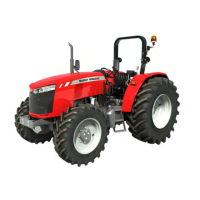Safety Notes
4200 cab - M2
WEO
15
● When going down a slope, use the throttle to slow
the tractor engine and use the same gear range you
would use to go up the slope. Shift into gear before
you start downhill.
● Engage four-wheel drive (if fitted), this will give four-
wheel braking.
WARNING: DO NOT disengage the clutch or
attempt to shift gear after you have started
downhill.
● It is less likely that the tractor will overturn if you
travel straight up or down a steep slope rather than
across it.
● Avoid crossing steep slopes if possible. If you must
do so, avoid any holes or depressions on the downhill
side. Avoid any stumps, rocks, bumps or raised areas
on the uphill side. When operating near ditches and
banks, always keep your tractor behind the shear line
(A, Fig. 19). Avoid ditches, embankments and river-
banks which might cave in.
● If it is necessary to cross a steep slope, avoid turning
uphill, slow down and make a wide turn. Travel
directly up or down the slope, never across it. When
travelling up or down a slope, keep the heavy end of
the tractor on the uphill side.
● If when travelling across a slope with side mounted
implements, keep the implement on the uphill side.
Do not raise the implements. Keep them as low to
the ground as possible when crossing a slope.
● When towing a load at transport speed or in the field,
lock the drawbar in the centre position and use a
safety chain.
●
DO NOT use your tractor to round up farm animals.
To Avoid Rear Overturns
WARNING: Hitching to the rear axle, or any
other point above the swinging drawbar, can
cause a rear overturn.
●
DO NOT pull anything using the top link connection,
or from any point above the centre line of the rear
axle. Always use an approved Massey Ferguson
drawbar, and only use a drawbar pin that locks in
place.
● High hitching can cause rear overturn, which may
cause serious injury or death. Hitch loads to the
drawbar only.
● Only use a three-point linkage drawbar when stays
are fitted to keep it in the down position.
● Use front counterweights to increase tractor stability
when towing a heavy load or to counter balance a
heavy rear mounted implement (Fig. 20).
● Start forward slowly and gradually increase your
speed. DO NOT rev the engine or drop the clutch. If
the tractor is attached to a heavy load, or immovable
object, improper clutching may cause overturn.
● If the front end of the tractor starts to lift, reduce your
speed and, if necessary, disengage the clutch.
●
If your tractor is bogged down in mud or frozen to the
ground, DO NOT attempt to drive forwards. The
tractor can rotate around its rear wheels and
overturn. Lift any attached implement and attempt to
BACK OUT. If this is not possible, tow it out with
another vehicle.
Fig. 19
Fig. 20
● If you get stuck in a ditch,
BACK OUT, if possible. If
you must go forward, do it slowly and carefully.
● A bare tractor or tractor with rear mounted
attachments should be backed up the slope in reverse
and travel forward downhill.
● A tractor with a loaded front-end bucket should be
backed down the slope and travel forward uphill.
Keep the loader bucket as low as possible.
● Always keep the tractor in gear when going downhill.
DO NOT permit the tractor to coast with clutch
disengaged or transmission in neutral.
TL 3729
TL 3383

